2008 Seat Ibiza 5D window
[x] Cancel search: windowPage 105 of 260
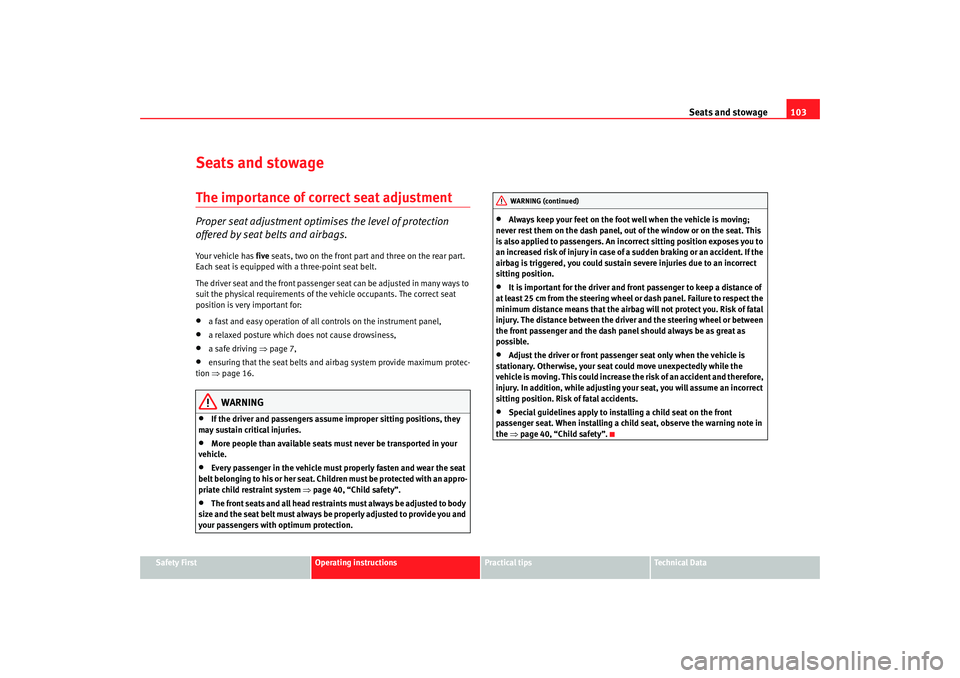
Seats and stowage103
Safety First
Operating instructions
Practical tips
Te c h n i c a l D a t a
Seats and stowageThe importance of correct seat adjustmentProper seat adjustment optimi ses the level of protection
offered by seat belts and airbags.Your vehicle has five seats, two on the front part and three on the rear part.
Each seat is equipped with a three-point seat belt.
The driver seat and the front passenger seat can be adjusted in many ways to
suit the physical requirements of the vehicle occupants. The correct seat
position is very important for:•
a fast and easy operation of all controls on the instrument panel,
•
a relaxed posture which does not cause drowsiness,
•
a safe driving ⇒page 7,
•
ensuring that the seat belts and airbag system provide maximum protec-
tion ⇒page 16.
WARNING
•
If the driver and passengers assume improper sitting positions, they
may sustain critical injuries.
•
More people than available seats must never be transported in your
vehicle.
•
Every passenger in the vehicle must properly fasten and wear the seat
belt belonging to his or her seat. Children must be protected with an appro-
priate child restraint system ⇒page 40, “Child safety”.
•
The front seats and all head restraints must always be adjusted to body
size and the seat belt must always be properly adjusted to provide you and
your passengers with optimum protection.
•
Always keep your feet on the foot well when the vehicle is moving;
never rest them on the dash panel, out of the window or on the seat. This
is also applied to passengers. An inco rrect sitting position exposes you to
an increased risk of injury in case of a sudden braking or an accident. If the
airbag is triggered, you could sustain severe injuries due to an incorrect
sitting position.
•
It is important for the driver and front passenger to keep a distance of
at least 25 cm from the steering wheel or dash panel. Failure to respect the
minimum distance means that the airbag will not protect you. Risk of fatal
injury. The distance between the driver and the steering wheel or between
the front passenger and the dash panel should always be as great as
possible.
•
Adjust the driver or front passenger seat only when the vehicle is
stationary. Otherwise, your seat could move unexpectedly while the
vehicle is moving. This could increase the risk of an accident and therefore,
injury. In addition, while adjusting your seat, you will assume an incorrect
sitting position. Risk of fatal accidents.
•
Special guidelines apply to installing a child seat on the front
passenger seat. When installing a child seat, observe the warning note in
the ⇒page 40, “Child safety”.WARNING (continued)
Ibiza250_angles Seite 103 Dienstag, 5. August 2008 1:11 13
Page 118 of 260
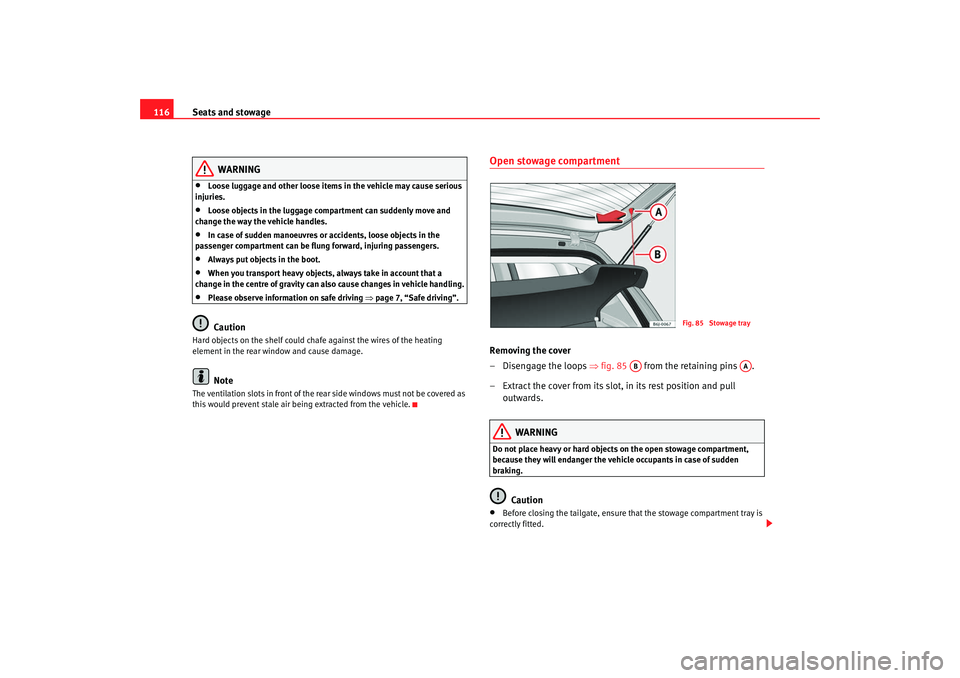
Seats and stowage
116
WARNING
•
Loose luggage and other loose items in the vehicle may cause serious
injuries.
•
Loose objects in the luggage compartment can suddenly move and
change the way the vehicle handles.
•
In case of sudden manoeuvres or accidents, loose objects in the
passenger compartment can be flung forward, injuring passengers.
•
Always put objects in the boot.
•
When you transport heavy objects, always take in account that a
change in the centre of gravity can also cause changes in vehicle handling.
•
Please observe information on safe driving ⇒page 7, “Safe driving”.Caution
Hard objects on the shelf could chafe against the wires of the heating
element in the rear window and cause damage.
Note
The ventilation slots in front of the rear side windows must not be covered as
this would prevent stale air being extracted from the vehicle.
Open stowage compartmentRemoving the cover
– Disengage the loops ⇒fig. 85 from the retaining pins .
– Extract the cover from its slot, in its rest position and pull outwards.
WARNING
Do not place heavy or hard objects on the open stowage compartment,
because they will endanger the vehicle occupants in case of sudden
braking.
Caution
•
Before closing the tailgate, ensure th at the stowage compartment tray is
correctly fitted.
Fig. 85 Stowage tray
AB
AA
Ibiza250_angles Seite 116 Dienstag, 5. August 2008 1:11 13
Page 120 of 260
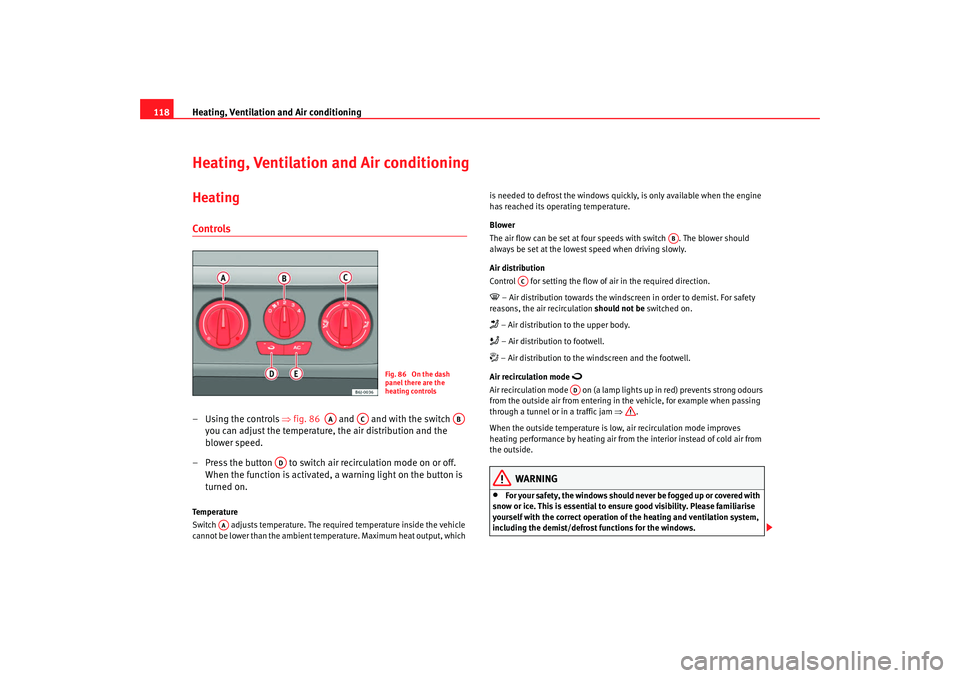
Heating, Ventilation and Air conditioning
118Heating, Ventilation and Air conditioningHeatingControls– Using the controls ⇒fig. 86 and and with the switch
you can adjust the temperature, the air distribution and the
blower speed.
– Press the button to switch air recirculation mode on or off. When the function is activated, a warning light on the button is
turned on.Temperature
Switch adjusts temperature. The required temperature inside the vehicle
cannot be lower than the ambient temp erature. Maximum heat output, which is needed to defrost the windows quickly, is only available when the engine
has reached its operating temperature.
Blower
The air flow can be set at four speeds with switch . The blower should
always be set at the lowest speed when driving slowly.
Air distribution
Control for setting the flow of
air in the required direction.
– Air distribution towards the windsc reen in order to demist. For safety
reasons, the air recirculation should not be switched on. – Air distribution to the upper body. – Air distribution to footwell. – Air distribution to the windscreen and the footwell.
Air recirculation mode
Air recirculation mode on (a lamp ligh ts up in red) prevents strong odours
from the outside air from entering in the vehicle, for example when passing
through a tunnel or in a traffic jam ⇒ .
When the outside temperature is low , air recirculation mode improves
heating performance by heating air from the interior instead of cold air from
the outside.
WARNING
•
For your safety, the windows should never be fogged up or covered with
snow or ice. This is essential to ensure good visibility. Please familiarise
yourself with the correct operation of the heating and ventilation system,
including the demist/defrost functions for the windows.
Fig. 86 On the dash
panel there are the
heating controls
AA
AC
AB
AD
AA
AB
AC
AD
Ibiza250_angles Seite 118 Dienstag, 5. August 2008 1:11 13
Page 121 of 260
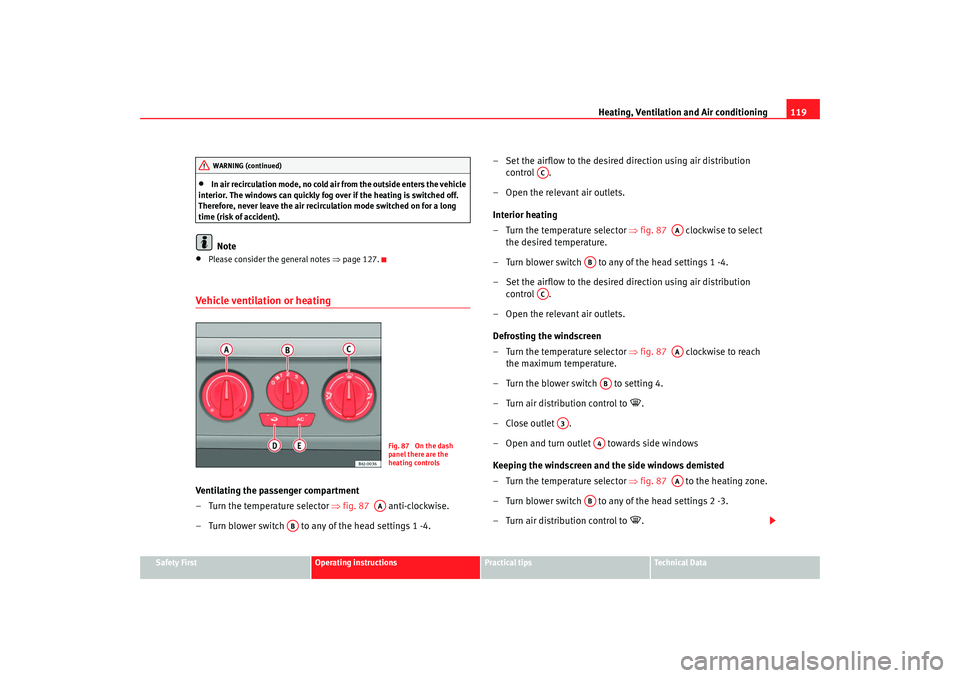
Heating, Ventilation and Air conditioning 119
Safety First
Operating instructions
Practical tips
Te c h n i c a l D a t a
•
In air recirculation mode, no cold ai r from the outside enters the vehicle
interior. The windows can quickly fog over if the heating is switched off.
Therefore, never leave the air recircul ation mode switched on for a long
time (risk of accident).Note
•
Please consider the general notes ⇒page 127.
Vehicle ventilation or heatingVentilating the passenger compartment
– Turn the temperature selector ⇒ fig. 87 anti-clockwise.
– Turn blower switch to any of the head settings 1 -4. – Set the airflow to the desired direction using air distribution
control .
– Open the relevant air outlets.
Interior heating
– Turn the temperature selector ⇒ fig. 87 clockwise to select
the desired temperature.
– Turn blower switch to any of the head settings 1 -4.
– Set the airflow to the desired direction using air distribution control .
– Open the relevant air outlets.
Defrosting the windscreen
– Turn the temperature selector ⇒ fig. 87 clockwise to reach
the maximum temperature.
– Turn the blower switch to setting 4.
– Turn air distribution control to
.
–Close outlet .
– Open and turn outlet towards side windows
Keeping the windscreen and the side windows demisted
– Turn the temperature selector ⇒ fig. 87 to the heating zone.
– Turn blower switch to any of the head settings 2 -3.
– Turn air distribution control to
.
WARNING (continued)
Fig. 87 On the dash
panel there are the
heating controls
AA
AB
AC
AA
AB
AC
AA
AB
A3
A4
AA
AB
Ibiza250_angles Seite 119 Dienstag, 5. August 2008 1:11 13
Page 122 of 260

Heating, Ventilation and Air conditioning
120
– Close outlets .
– Open and turn outlets towards side windows.Once the windows are demisted and as a preventive measure, the control
can be set in position
, thus obtaining greater comfort while preventing the
windows from misting again. Heating
Maximum heat output, which is needed to defrost the windows quickly, is
only available when the engine has reached its operating temperature.
Note
Remember that the temperature of the engine coolant should be optimum to
ensure that the heating system functions correctly (except in vehicles fitted
with additional heating*)
Air outlets
A3
A4
AC
Fig. 88 Air vent
Ibiza250_angles Seite 120 Dienstag, 5. August 2008 1:11 13
Page 124 of 260

Heating, Ventilation and Air conditioning
122
– Turn the fan control to one of the two levels depending on the
speed required.
– Rotate the temperature control to the desired level of comfort.
– Close outlets .
– Open and turn outlets towards side windows.
Temperature selector ⇒page 122
Blower control. There are four speed settings for the blower. At low
speed, the blower should be set to a minimum of 1 to improve the intake
of fresh air.
Air distribution control ⇒page 122
Air recirculation button ⇒page 123
Button – Coolant on button ⇒page 122WARNING
For your safety, the windows should never be fogged up or covered with
snow or ice. This is essential to ensure good visibility. Please familiarise
yourself with the correct operation of the heating and ventilation system,
including the demist/defrost functions for the windows.
Note
Please consider the general notes.
Vehicle interior heating or cooling system Interior heating
– Disconnect the cooling system using button ⇒fig. 90 (the
button light turns off).
– Turn the temperature selector to set the desired temperature inside the vehicle.
– Turn the blower switch to any of the settings 1-4.
– Set the air distribution control to the air flow configuration desired: (towards the windscreen), (towards the chest), (towards the footwell) and (towards the windscreen and
footwell areas).
Interior cooling
– Connect the cooling system with button (the button light
should light up).
A3
A4
AAABACAD
AE
AC
Fig. 90 Air conditioning
controls on the instru-
ment panel
AC
AAAC
AC
Ibiza250_angles Seite 122 Dienstag, 5. August 2008 1:11 13
Page 125 of 260
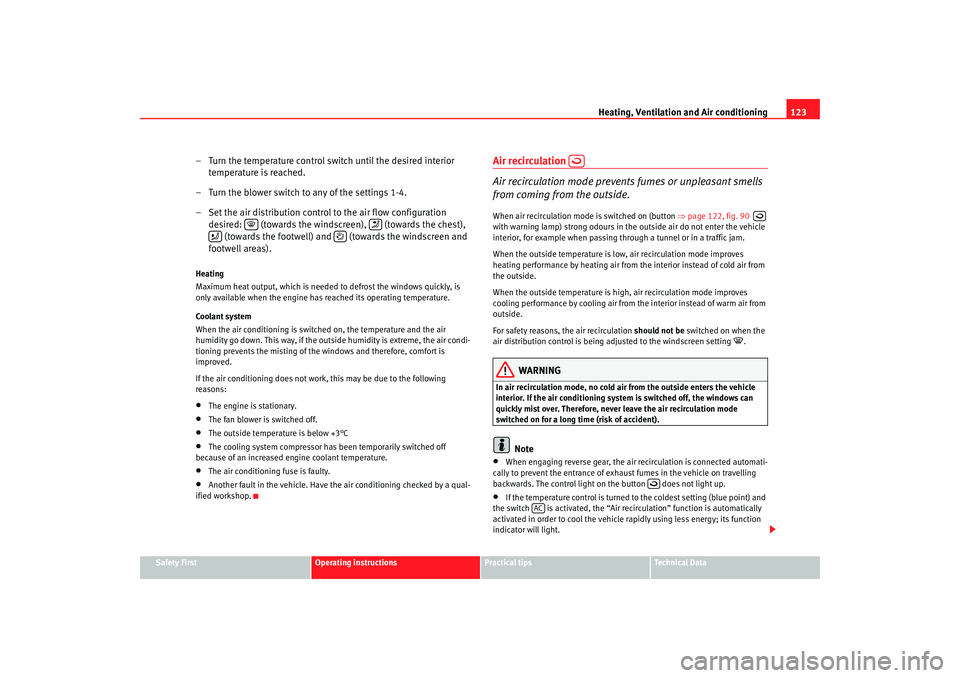
Heating, Ventilation and Air conditioning 123
Safety First
Operating instructions
Practical tips
Te c h n i c a l D a t a
– Turn the temperature control switch until the desired interior
temperature is reached.
– Turn the blower switch to any of the settings 1-4.
– Set the air distribution control to the air flow configuration desired: (towards the windsc reen), (towards the chest),
(towards the footwell) and (towards the windscreen and
footwell areas).Heating
Maximum heat output, which is needed to defrost the windows quickly, is
only available when the engine has reached its operating temperature.
Coolant system
When the air conditioning is switched on, the temperature and the air
humidity go down. This way, if the outside humidity is extreme, the air condi-
tioning prevents the misting of the windows and therefore, comfort is
improved.
If the air conditioning does not work, this may be due to the following
reasons:•
The engine is stationary.
•
The fan blower is switched off.
•
The outside temperature is below +3°C
•
The cooling system compressor has been temporarily switched off
because of an increased engine coolant temperature.
•
The air conditioning fuse is faulty.
•
Another fault in the vehicle. Have the air conditioning checked by a qual-
ified workshop.
Air recirculation
Air recirculation mode prevents fumes or unpleasant smells
from coming from the outside.When air recirculation mode is switched on (button ⇒page 122, fig. 90
with warning lamp) strong odours in th e outside air do not enter the vehicle
interior, for example when passing through a tunnel or in a traffic jam.
When the outside temperature is low, air recirculation mode improves
heating performance by heating air from the interior instead of cold air from
the outside.
When the outside temperature is high, air recirculation mode improves
cooling performance by cooling air from the interior instead of warm air from
outside.
For safety reasons, the air recirculation should not be switched on when the
air distribution control is being adjusted to the windscreen setting
.
WARNING
In air recirculation mode, no cold air from the outside enters the vehicle
interior. If the air conditioning syst em is switched off, the windows can
quickly mist over. Therefore, never leave the air recirculation mode
switched on for a long time (risk of accident).
Note
•
When engaging reverse gear, the air recirculation is connected automati-
cally to prevent the entrance of exhaust fumes in the vehicle on travelling
backwards. The control light on the button does not light up.
•
If the temperature control is turned to the coldest setting (blue point) and
the switch is activated, the “Air recirculation” function is automatically
activated in order to cool the vehicle rapidly using less energy; its function
indicator will light.
AC
Ibiza250_angles Seite 123 Dienstag, 5. August 2008 1:11 13
Page 126 of 260
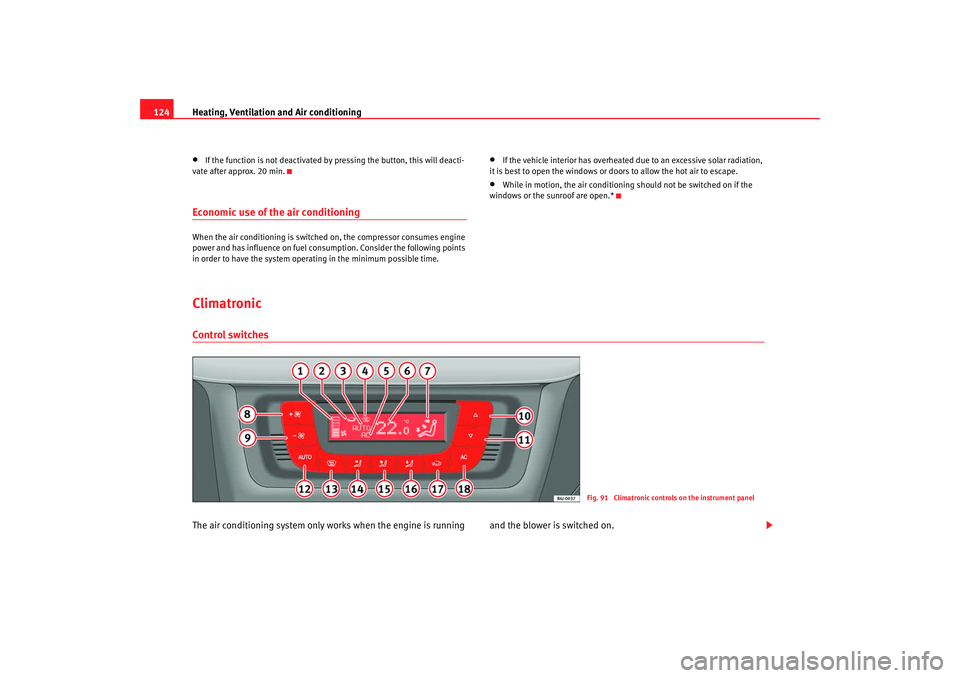
Heating, Ventilation and Air conditioning
124•
If the function is not deactivated by pressing the button, this will deacti-
vate after approx. 20 min.
Economic use of the air conditioningWhen the air conditioning is switched on, the compressor consumes engine
power and has influence on fuel consumption. Consider the following points
in order to have the system operating in the minimum possible time.
•
If the vehicle interior has overheated due to an excessive solar radiation,
it is best to open the windows or doors to allow the hot air to escape.
•
While in motion, the air conditioning should not be switched on if the
windows or the sunroof are open.*
ClimatronicControl switchesThe air conditioning system only works when the engine is running and the blower is switched on.
Fig. 91 Climatronic controls on the instrument panel
Ibiza250_angles Seite 124 Dienstag, 5. August 2008 1:11 13